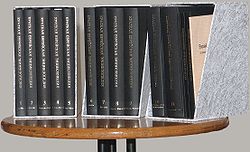
Shorter Jewish Encyclopedia
Encyclopedia

Russian language
Russian is a Slavic language used primarily in Russia, Belarus, Uzbekistan, Kazakhstan, Tajikistan and Kyrgyzstan. It is an unofficial but widely spoken language in Ukraine, Moldova, Latvia, Turkmenistan and Estonia and, to a lesser extent, the other countries that were once constituent republics...
by the Society for Research on Jewish Communities with the support of Hebrew University in Jerusalem. The SJE is the only comprehensive encyclopedia on Judaism published in Russian, and followed an almost 70-year gap following the publication of the "Yevreyskaya Entsiklopedia" (Encyclopedia Judaica) of Brokhaus and Efron
Brockhaus and Efron Encyclopedic Dictionary
The Brockhaus and Efron Encyclopedic Dictionary is, in its scope and style, the Russian counterpart to the Encyclopædia Britannica. It contains 121,240 articles, 7,800 images, and 235 maps...
in Saint Petersburg
Saint Petersburg
Saint Petersburg is a city and a federal subject of Russia located on the Neva River at the head of the Gulf of Finland on the Baltic Sea...
in 1908.
Although it was originally planned as an abridged translation of the English-language Encyclopedia Judaica, it became clear as the work progressed that readers raised in the Soviet Union
Soviet Union
The Soviet Union , officially the Union of Soviet Socialist Republics , was a constitutionally socialist state that existed in Eurasia between 1922 and 1991....
would not in general be familiar with the concepts lying at the foundation of the cultural and historical system known as Jewish civilization. Therefore, these concepts were elaborated in greater detail in the SJE, and terms were introduced which lacked equivalents in modern Russian. Most personal and geographic names (in Israel
Israel
The State of Israel is a parliamentary republic located in the Middle East, along the eastern shore of the Mediterranean Sea...
) from the Bible are given in the accepted Hebrew form. The conceptual foundation of the SJE is characterized by a thematic bipolarity: Eretz Israel, and in particular the Israeli Government on the one hand, and Russian (i.e., Soviet) Jewry on the other, which nevertheless does not exclude the broad scope of different aspects of the lives and history of Jews in all the countries of the diaspora
Diaspora
A diaspora is "the movement, migration, or scattering of people away from an established or ancestral homeland" or "people dispersed by whatever cause to more than one location", or "people settled far from their ancestral homelands".The word has come to refer to historical mass-dispersions of...
.
A group of editors worked on the SJE who prepared articles with the participation of invited specialists and also academic consultants, including the well-known Israeli academics and public figures Shraga Abramson, Mordechai Altschuler, Shlomo Pines
Shlomo Pines
Shlomo Pines was a scholar of Jewish and Islamic philosophy, best known for his English translation of Maimonides' Guide to the Perplexed.-Biography:...
, Hayim Tadmor
Hayim Tadmor
Hayim Tadmor was a leading Israeli Assyriologist, and a profound influence on many students and scholars of the Ancient Near East throughout the world. A superb teacher and inspiring lecturer, his multilingual wit was known in many countries...
, Chone Shmeruk, Haim Shirman, Menachem Stern, Yaakov Tsur, Yaakov Landau, Israel Bartal, and Michael Liebman. Chairing the editorial board were Shmuel Ettinger and Haim Beinhart. Chief editors were Yitzhak Oren (Nadel), Michael Zand, Naftali Prat, and Ari Avner. The senior academic editors were Peretz Hein, Yosef Glozman, Amnon Ginzai, and Mark Kipnis. The managing editors were Ella Slivkina (vol. 1-10) and Marina Gutgarts.
In practical terms, the SJE was no longer "shorter," and aside from the 11 volumes a "Jewish calendar juxtaposed with a Gregorian calendar (1948-2048)" was published as a pamphlet along with three supplements. Volume 10 also contains a "thematic bibliographic index" with 2,114 items. There are more than 5,300 vocabulary entries, and the total number of words exceeds six million. Volume 11, the final one, included an alphabetized index of subjects, including geographic and personal names and events with references to the volume and column where they are located. A system of citations indicating links between concepts serves as the only cross-reference in the entire corpus of the encyclopedia.
In 1996, the Society for Research on Jewish Communities undertook a reprinting of the first seven volumes of the SJE, which were printed by the printing and publishing house "Krasnyj Proletarij" in Moscow.
In 2005, the Electronic Jewish Encyclopedia (EJE), (Elektronnaja Evrejskaja Entsiklopedia) was made available on the internet, presenting an expanded and more precise version of the SJE. Work on the EJE continues today.

